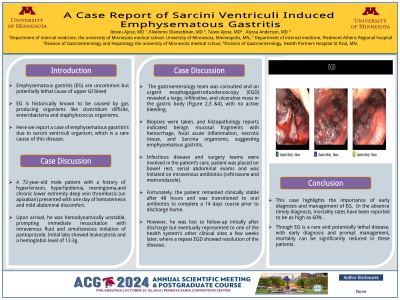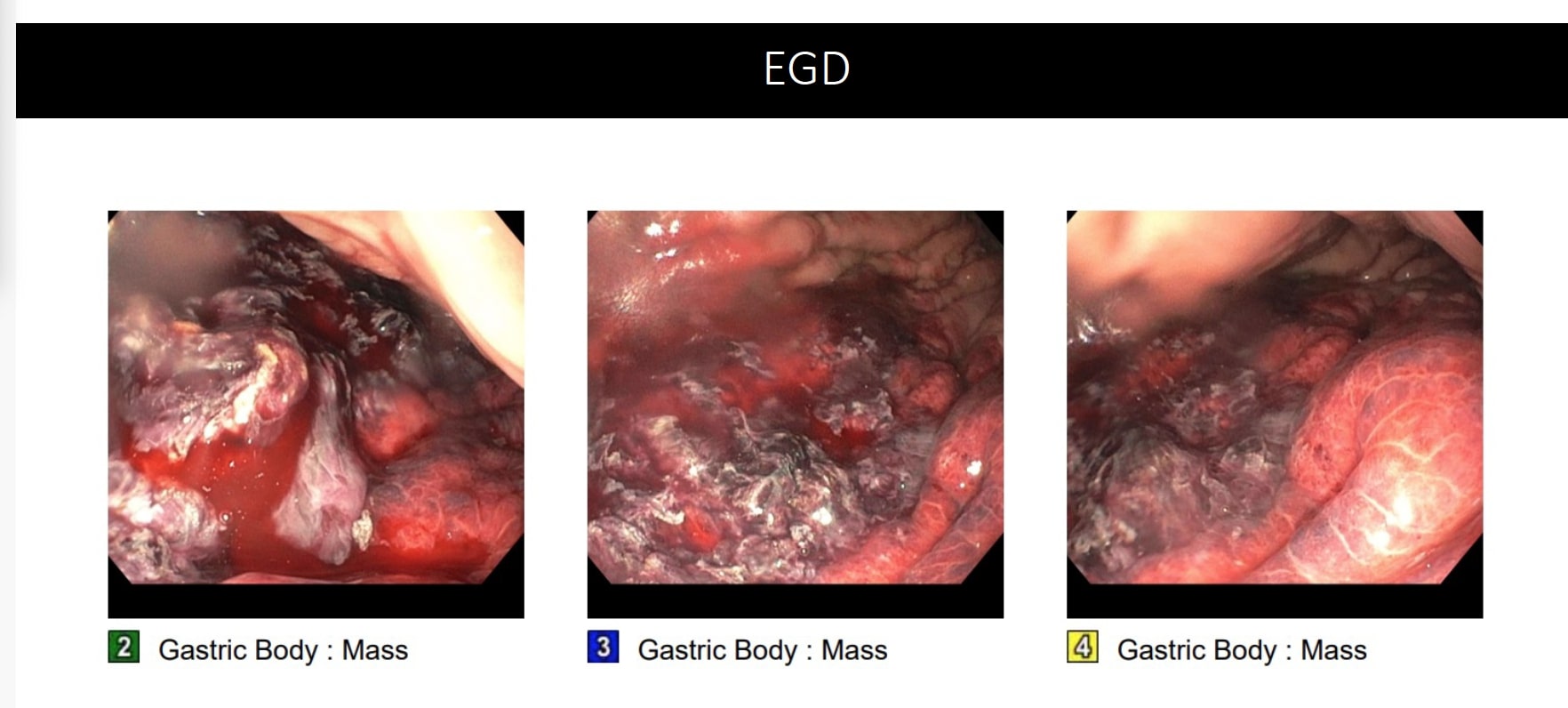Sunday Poster Session
Category: Stomach
P1639 - A Case Report of Sarcini Ventriculi Induced Emphysematous Gastritis
Sunday, October 27, 2024
3:30 PM - 7:00 PM ET
Location: Exhibit Hall E

Has Audio

Idowu Ajose, MD
University of Minnesota
Minneapolis, MN
Presenting Author(s)
Idowu Ajose, MD1, Kikelomo Olaosebikan, MD2, Taiwo Ajose, MD3, Alyssa Anderson, MD4
1University of Minnesota, Minneapolis, MN; 2Piedmont Athens Regional, Athens, GA; 3The University of Minnesota Medical School, Minneapolis, MN; 4Health Partners Hospital, St. Paul, MN
Introduction: Emphysematous gastritis (EG) are uncommon but potentially lethal cause of upper GI bleed. EG
is historically known to be caused by gas producing organisms like clostridium difficile,
enterobacteria and staphylococcus organisms. Here we report a case of emphysematous
gastritis’s due to sarcini ventriculi organism, which is a rare cause of this disease.
Case Description/Methods: A 72-year-old male patient with a history of hypertension, hyperlipidemia, meningioma, and
chronic lower extremity deep vein thrombosis (on apixaban) presented with one day of
hematemesis and mild abdominal discomfort. Upon arrival, he was hemodynamically unstable,
prompting immediate resuscitation with intravenous fluid and simultaneous initiation of
pantoprazole. Initial labs showed leukocytosis and a hemoglobin level of 13.3g.
The gastroenterology team was consulted and an urgent esophagogastroduodenoscopy (EGD)
revealed a large, infiltrative, and ulcerative mass in the gastric body (Figure 2,3 &4), with no
active bleeding. Biopsies were taken, and histopathology reports indicated benign mucosal
fragments with hemorrhage, focal acute inflammation, necrotic tissue, and Sarcina organisms,
suggesting emphysematous gastritis.
Infectious disease and surgery teams were involved in the patient’s care, patient was placed on
bowel rest, serial abdominal exams and was initiated on intravenous antibiotics (ceftriaxone
and metronidazole). Fortunately, the patient remained clinically stable after 48 hours and was
transitioned to oral antibiotics to complete a 14 days course prior to discharge home. However,
he was lost to follow-up initially after discharge but eventually represented to one of the health
system's other clinical sites a few weeks later, where a repeat EGD showed resolution of the
disease.
Discussion: This case highlights the importance of early diagnosis and management of EG. In the absence
timely diagnosis, mortality rates have been reported to be as high as 60% . Though EG is a rare
and potentially lethal disease, with early diagnosis and prompt management, mortality can be
significantly reduced in these patients.

Disclosures:
Idowu Ajose, MD1, Kikelomo Olaosebikan, MD2, Taiwo Ajose, MD3, Alyssa Anderson, MD4. P1639 - A Case Report of Sarcini Ventriculi Induced Emphysematous Gastritis, ACG 2024 Annual Scientific Meeting Abstracts. Philadelphia, PA: American College of Gastroenterology.
1University of Minnesota, Minneapolis, MN; 2Piedmont Athens Regional, Athens, GA; 3The University of Minnesota Medical School, Minneapolis, MN; 4Health Partners Hospital, St. Paul, MN
Introduction: Emphysematous gastritis (EG) are uncommon but potentially lethal cause of upper GI bleed. EG
is historically known to be caused by gas producing organisms like clostridium difficile,
enterobacteria and staphylococcus organisms. Here we report a case of emphysematous
gastritis’s due to sarcini ventriculi organism, which is a rare cause of this disease.
Case Description/Methods: A 72-year-old male patient with a history of hypertension, hyperlipidemia, meningioma, and
chronic lower extremity deep vein thrombosis (on apixaban) presented with one day of
hematemesis and mild abdominal discomfort. Upon arrival, he was hemodynamically unstable,
prompting immediate resuscitation with intravenous fluid and simultaneous initiation of
pantoprazole. Initial labs showed leukocytosis and a hemoglobin level of 13.3g.
The gastroenterology team was consulted and an urgent esophagogastroduodenoscopy (EGD)
revealed a large, infiltrative, and ulcerative mass in the gastric body (Figure 2,3 &4), with no
active bleeding. Biopsies were taken, and histopathology reports indicated benign mucosal
fragments with hemorrhage, focal acute inflammation, necrotic tissue, and Sarcina organisms,
suggesting emphysematous gastritis.
Infectious disease and surgery teams were involved in the patient’s care, patient was placed on
bowel rest, serial abdominal exams and was initiated on intravenous antibiotics (ceftriaxone
and metronidazole). Fortunately, the patient remained clinically stable after 48 hours and was
transitioned to oral antibiotics to complete a 14 days course prior to discharge home. However,
he was lost to follow-up initially after discharge but eventually represented to one of the health
system's other clinical sites a few weeks later, where a repeat EGD showed resolution of the
disease.
Discussion: This case highlights the importance of early diagnosis and management of EG. In the absence
timely diagnosis, mortality rates have been reported to be as high as 60% . Though EG is a rare
and potentially lethal disease, with early diagnosis and prompt management, mortality can be
significantly reduced in these patients.

Figure: Figure 2,3,4
Disclosures:
Idowu Ajose indicated no relevant financial relationships.
Kikelomo Olaosebikan indicated no relevant financial relationships.
Taiwo Ajose indicated no relevant financial relationships.
Alyssa Anderson indicated no relevant financial relationships.
Idowu Ajose, MD1, Kikelomo Olaosebikan, MD2, Taiwo Ajose, MD3, Alyssa Anderson, MD4. P1639 - A Case Report of Sarcini Ventriculi Induced Emphysematous Gastritis, ACG 2024 Annual Scientific Meeting Abstracts. Philadelphia, PA: American College of Gastroenterology.
